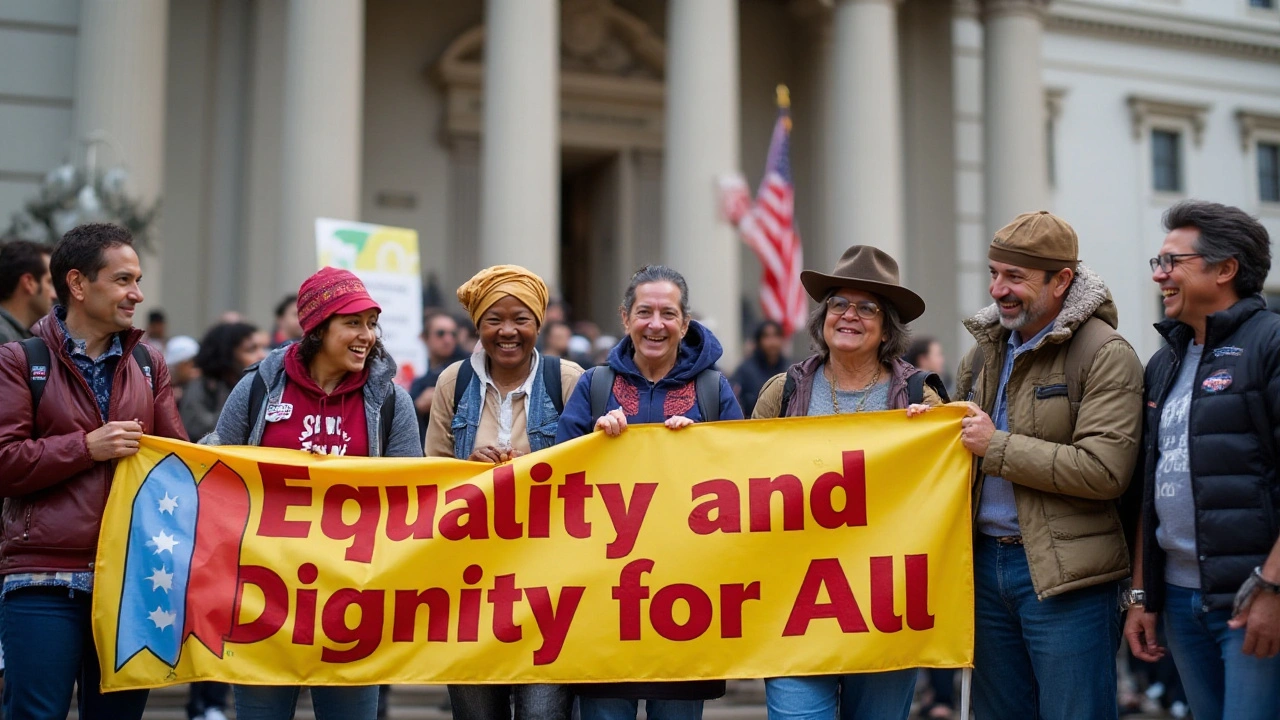
Leprosy, a disease shrouded in stigma and misunderstanding, has been a part of human history for centuries. Though medical advances have made it manageable and treatable, leprosy still carries a heavy burden of societal discrimination.
The historical wrongly associating leprosy with myths and beliefs led to widespread fear and ostracization of those affected. Over time, this perception has slowly shifted, but the stigma remains in many places.
A more empathetic approach, recognizing the rights and dignity of patients, is essential. Organizations worldwide are working tirelessly to change the narrative, ensuring patients are treated with the respect they deserve. By focusing on education and human rights advocacy, we can make significant strides toward equality and dignity for all leprosy-affected individuals.
- Understanding Leprosy: Causes and Symptoms
- Historical Stigmatization and Discrimination
- Progress in Treatment and Perception
- Human Rights Advocacy Efforts
- Steps Towards Equality and Dignity
Understanding Leprosy: Causes and Symptoms
Leprosy, also known as Hansen's disease, is caused by the bacterium Mycobacterium leprae. This organism affects the skin, peripheral nerves, mucosa of the upper respiratory tract, and the eyes. It's considered a chronic infectious disease that mainly spreads through droplets, from the nose and mouth, during close and frequent contact with untreated cases. However, it's important to note that leprosy is not highly contagious and can be effectively treated.
The symptoms of leprosy can vary greatly depending on the type and stage of infection. Early signs are often subtle and can include patches of skin that are lighter or darker than the normal skin tone. These patches may feel numb and don't sweat because the nerves in those areas are affected. In some cases, there may be muscle weakness, and over time, the condition can lead to more severe symptoms like deformities or disabilities if not promptly treated.
People affected by leprosy often experience numbness and loss of sensation in the hands, feet, and face. This loss of sensation can lead to repeated injuries or secondary infections, which in turn can result in the loss of fingers and toes or blindness. Despite these severe outcomes, it's crucial to understand that with early diagnosis and treatment using multidrug therapy (MDT), these complications can be minimized or avoided entirely.
According to the World Health Organization, around 200,000 new cases of leprosy are reported globally each year, with the majority found in countries like India, Brazil, and Indonesia. This statistic underscores the importance of continued vigilance and public health efforts in combating the disease worldwide.
"The bacteria that cause leprosy can live inside infected individuals for up to 20 years without showing any symptoms," says Dr. Christine Petersen from the University of Iowa. This long incubation period makes it difficult to pinpoint the time and place of infection, complicating efforts to control its spread.
While the medical community has made significant progress in diagnosing and treating leprosy, understanding its early signs is still vital for effective management. Health workers and affected individuals need to recognize the early skin patches and seek immediate medical attention. It’s equally important to educate communities about the true nature of leprosy, to reduce the stigma and discrimination that often surround it.
In summary, leprosy is a complex but manageable condition. Knowing its causes and recognizing its symptoms early can lead to timely treatment and significantly improve the quality of life for those affected. Increased awareness and education can help eliminate the social stigma and ensure that everyone with leprosy receives the care and respect they deserve.
Historical Stigmatization and Discrimination
For hundreds of years, leprosy has been misunderstood, often associated with myths and superstitions. This misunderstanding has led to deep-rooted discrimination and stigmatization of individuals diagnosed with the disease. In medieval Europe, lepers were forced to wear special clothing and ring bells to announce their presence, isolating them from society and reinforcing the notion they were to be feared.
Even religious texts have played a role in framing leprosy in a negative light, often portraying it as a divine punishment for sin. This religious context contributed to the marginalization of leprosy sufferers, who were seen not just as physically unclean but spiritually tainted. This chronic misunderstanding has perpetuated social exclusion and emotional suffering for those diagnosed with the disease.
Historical records from India indicate that leprosy patients were often banished from their communities and forced to live in leper colonies. These colonies were usually in remote areas, far from the main population centers, making it difficult for affected individuals to receive medical care or societal support. The leprosy stigma wasn't limited to social exclusion; it also affected people's livelihoods and familial relationships.
In some cultures, families disowned members who were diagnosed with leprosy to avoid stigma by association. For instance, in 19th century Japan, the policy mandated the segregation of leprosy patients, who were often placed in remote islands. Such policies contributed significantly to the isolation and despair experienced by these individuals. The long-standing prejudice against people with leprosy also found its way into the legal system.
The British colonial law in India, the 'Lepers Act' of 1898, mandated the segregation of individuals with leprosy into asylums. It wasn't until 1983 that this law was repealed.
"Leprosy is possibly the most stigmatized disease in human history," remarks Dr. Yohei Sasakawa, WHO Goodwill Ambassador for Leprosy Elimination.Various accounts also highlight how the stigma surrounding leprosy interfered with proper medical care. Fear of social ostracization often prompted individuals to hide symptoms and avoid seeking medical attention, inadvertently contributing to the spread of the disease.
Over time, some progress has been made in reducing the stigma associated with leprosy, largely due to better understanding of its causes and more effective treatments. Education campaigns and the efforts of numerous non-governmental organizations have played a role in shifting perceptions. However, the battle is far from over. The enduring legacy of discrimination continues to affect many individuals diagnosed with leprosy today. Recognizing and confronting this historical prejudice is crucial in fostering a more inclusive and understanding society.

Progress in Treatment and Perception
Since ancient times, leprosy has been a disease enveloped in mystery and fear. The significant strides made in modern medicine have demystified this illness substantially. Notably, the development of multi-drug therapy (MDT) in the 1980s revolutionized the treatment landscape for leprosy patients. This treatment, consisting of a combination of dapsone, rifampicin, and clofazimine, has proven highly effective. It not only cures the disease but also halts its transmission, drastically reducing new cases worldwide. According to the World Health Organization (WHO), over 16 million people have been cured of leprosy since MDT became widely available.
These medical advances have significantly changed how society perceives leprosy. Earlier, widespread misconceptions linked the disease to moral failings or divine punishment. However, education and awareness campaigns have debunked these myths. The stigma, though still present in certain regions, is gradually reducing as people come to understand that leprosy is neither highly contagious nor a result of personal fault. Awareness programs emphasize that with timely diagnosis and treatment, individuals affected by leprosy can lead fulfilling lives without lasting disability.
It’s heartening to highlight initiatives like the Global Leprosy Program by WHO and other organizations. These efforts focus on reducing the disease's burden and combating discrimination. These entities push for widespread screening, ensuring early detection and comprehensive care to prevent disabilities associated with untreated leprosy. By focusing on public health education, they contribute greatly to reshaping societal attitudes towards the disease. Former leprosy patients often participate in these campaigns, sharing their stories to inspire acceptance and compassion.
Dr. Anil Kumar of the National Leprosy Eradication Programme states, "The battle against leprosy is not just medical; it's a fight for dignity and equality. The more we educate, the more we break the chains of ignorance and prejudice."
A look at India's example provides a compelling case study of progress. Home to the highest number of leprosy cases globally, India launched ambitious national programs to eliminate the disease. Their multi-pronged approach included public education, mass drug administration, and the integration of leprosy care into general healthcare services. According to India's Ministry of Health, these efforts led to a dramatic decline in new cases, and many states have declared themselves leprosy-free.
Advocacy plays a pivotal role in changing perceptions. Human rights advocates emphasize that individuals affected by leprosy deserve love, care, and respect like anyone else. Campaigns driven by compassion and humanism focus on eliminating discrimination in schools, workplaces, and communities, thereby breaking the cycle of stigma and isolation. Partnerships between governments, non-profits, and affected communities ensure holistic support for patients, including medical, psychological, and social support.
Lastly, let’s not forget the role special observances play in shaping public perception. Events like World Leprosy Day, observed on the last Sunday of January, bring global attention to the challenges faced by those affected by leprosy. These events provide a platform for sharing success stories, discussing challenges, and renewing commitments to a leprosy-free world. They serve as potent reminders that societal acceptance and understanding are as crucial as medical treatment in the fight against leprosy.
Human Rights Advocacy Efforts
The fight to uphold human rights for those affected by leprosy has seen significant progress over the years, thanks to dedicated advocacy efforts. These efforts are grounded in the recognition that individuals suffering from this disease deserve the same respect, equality, and dignity as anyone else. Yet, these advancements have not come easily, and much work remains to be done.
One pivotal force in this fight has been The International Federation of Anti-Leprosy Associations (ILEP), a coalition of 15 international non-governmental organizations. ILEP works tirelessly to ensure that those with leprosy receive adequate medical care while also pushing for societal changes that reduce stigma. Their campaigns often highlight how educating communities can strip away myths and misconceptions associated with the disease. The organization has helped implement policies that prevent discrimination in school admissions, employment, and even marriage.
Another significant player is the World Health Organization (WHO). In 1991, the WHO launched the Global Leprosy Strategy, which aims to reduce the burden of leprosy and eliminate the stigma attached to it. According to WHO, the primary goals are early detection, effective treatment, and ensuring that patients are not marginalized. They work closely with governments to implement these strategies, stressing the importance of including leprosy patients in the decision-making process. This participatory approach ensures that the measures taken are both effective and sustainable.
The United Nations Human Rights Council has also been instrumental in advocating for the rights of people affected by leprosy. In 2010, the Council adopted a resolution urging member states to eliminate discrimination against these individuals. This resolution calls for states to promote inclusion, protect against discrimination, and provide necessary support services. Such international attention has gone a long way in elevating the discourse around leprosy, making it clear that this is not merely a health issue but a human rights concern.
“Leprosy is not just about the disease. It’s about the injustices that patients face,” stated Yohei Sasakawa, WHO Goodwill Ambassador for Leprosy Elimination.
Non-profit organizations at the grassroots level also play a critical role. Groups like The Leprosy Mission International focus on community-based rehabilitation, helping individuals regain their independence and dignity. These organizations often run skill training programs to empower people affected by leprosy to find livelihoods, thereby integrating them back into society. They also offer psychological support, which is crucial for those who have faced years of discrimination and rejection.
Technology has brought new tools to the advocacy arsenal. Social media campaigns, for instance, have proven effective in spreading awareness quickly and widely. Hashtags like #EndStigma and #LeprosyAwareness have become rallying points, bringing together voices from around the world in solidarity. These campaigns provide educational content and personal stories that help humanize those affected by the disease.
Despite these efforts, challenges remain. Cultural beliefs and lack of knowledge continue to perpetuate stigma in many parts of the world. Legal protections for leprosy patients are still inadequate in some countries, making it difficult for those affected to seek justice. Additionally, funding for leprosy programs often falls short, limiting the reach and effectiveness of advocacy efforts.
However, the combined force of international organizations, national governments, grassroots movements, and individual advocates creates a powerful engine for change. The ultimate goal is to build a world where having leprosy does not equate to a loss of dignity or basic human rights. As more people join the cause, the vision of a world free of leprosy-related discrimination becomes increasingly attainable.

Steps Towards Equality and Dignity
Achieving equality and dignity for individuals affected by leprosy requires a multi-faceted approach that addresses both medical treatment and socio-cultural perceptions. Central to this effort is comprehensive education that dispels myths and combats the stigma surrounding the disease. When communities understand that leprosy is treatable and not a curse, ostracization and discrimination can be reduced.
Another crucial step is the enforcement of human rights legislation that protects those living with leprosy from discriminatory practices. Many countries still have outdated laws that isolate or marginalize these individuals, and modernizing this legislation is key to ensuring they are treated equally. Legal frameworks need to guarantee access to healthcare, education, and employment without prejudice.
Advocacy plays a pivotal role in this journey towards equality. Organizations such as The Leprosy Mission and WHO are at the forefront of this battle, working to end leprosy-related discrimination globally. Their campaigns often highlight the voices of leprosy-affected individuals, providing a platform for them to tell their stories and advocate for their rights.
“We must listen to the voices of those affected by leprosy and support their fight for dignity and equality,” says Dr. Anil Kumar, a renowned leprosy expert.
Another significant area of focus is the provision of mental health support. The psychological impact of discrimination can be profound, leading to social isolation and depression. Mental health services tailored to the needs of leprosy patients are essential, helping them to rebuild their confidence and integrate back into society.
Empowerment through education and vocational training is also a critical step. By providing individuals affected by leprosy with skills and opportunities, they can secure stable incomes and gain independence. Vocational programs not only enhance their livelihoods but also challenge societal norms by demonstrating their capabilities and resilience.
Community Engagement and Support
Engaging communities in the fight against leprosy-related stigma is essential. Community-based initiatives that encourage inclusion and build awareness can transform perceptions and foster acceptance. Support groups and local advocacy efforts can create a supportive environment where individuals feel valued and understood.
Finally, sustained global efforts and proper funding are necessary for maintaining progress. Funding from governments and international bodies is vital for research, advocacy, and treatment programs. By investing in these areas, we can move closer to a world where equality and dignity for all is not just a goal but a reality.





Comments (15)
Karla Luis
So we’re still talking about leprosy like it’s some medieval curse instead of a treatable bacterial infection? The fact that people still get kicked out of their families over this is insane. I’ve met people who’ve had it and they’re just… people. No bells. No robes. Just someone who needs antibiotics and maybe a hug.
jon sanctus
Let’s be real - this whole ‘human rights’ framing is just woke performative nonsense. Leprosy isn’t a social justice issue, it’s a public health problem. You don’t need to ‘dignify’ someone who’s got a disease that causes tissue necrosis. You need to isolate them, treat them, and move on. The romanticization of suffering is what’s actually dehumanizing.
Kenneth Narvaez
The pathophysiology of Mycobacterium leprae is fundamentally misunderstood in popular discourse. The bacilli exhibit a tropism for Schwann cells, leading to demyelination of peripheral nerves - this is not a moral failing, nor is it a metaphor for societal exclusion. The WHO’s MDT protocol achieves bactericidal efficacy with a 99.9% cure rate when administered correctly. The persistence of stigma is a sociocultural artifact, not a biomedical one.
Christian Mutti
My heart goes out to every single soul who has ever been cast out because of this disease. 🙏 The cruelty of history is unbearable. To be shunned by your own blood, your own village - it’s a wound that never heals. We must rise. We must change. We must be the light. 💫
Liliana Lawrence
OMG, I just cried reading this. 🥺😭 So many people don’t realize that leprosy isn’t contagious like the plague - it’s like, super hard to catch? Like, you’d have to live in a tiny hut with someone for 20 years? And then they get blamed for being ‘unclean’?? It’s just… so wrong. I’m sharing this everywhere. #EndStigma #LeprosyIsNotACurse 💖
Sharmita Datta
Actually, this is all part of a global population control agenda. The WHO and pharmaceutical companies profit from keeping leprosy alive as a ‘neglected disease’ so they can sell MDT drugs for decades. The real cure was suppressed in the 1970s - vitamin C and sunlight. But they don’t want you to know that. Also, the Indian government hides cases to look ‘progressive’ to the UN. I’ve seen the documents.
mona gabriel
People treat leprosy like it’s a horror movie when it’s just biology. You get infected, you get treated, you live. The real monster isn’t the bacteria - it’s the fear we let grow in our heads. And that fear? It’s passed down like a family recipe. Time to stop cooking it.
Phillip Gerringer
There’s a clear correlation between socioeconomic deprivation and leprosy incidence. The persistence of stigma is a symptom of systemic failure - not ignorance. People aren’t ‘superstitious,’ they’re reacting to generations of institutional abandonment. Until we fix housing, nutrition, and healthcare access, we’re just slapping band-aids on a hemorrhage.
jeff melvin
Let’s not pretend this is about dignity. It’s about liability. If you treat leprosy patients as equals, you open the door to lawsuits, insurance claims, and workplace integration. The real motivation isn’t compassion - it’s legal risk mitigation dressed up as virtue
Matt Webster
I’ve worked in rural clinics in Nepal. I’ve seen men who lost fingers but still taught kids to play guitar with their stumps. Women who walked 12 miles for medicine and then baked bread for the clinic staff. This isn’t about advocacy. It’s about witnessing. And if you can’t see the humanity in that, you’re the one who needs healing.
Stephen Wark
Another feel-good article about ‘dignity.’ Where’s the data? Who funded this? Who gets paid when we ‘raise awareness’? The real issue is that leprosy is still being diagnosed too late because people are too scared to go to the hospital. So instead of writing poetry, maybe we should fix the damn healthcare system.
Daniel McKnight
There’s something beautiful about how the body adapts - how nerves stop screaming when they’re damaged, how skin learns to numb itself so you don’t feel the burn. But the world? It never learned to numb itself to fear. We still see the scars and forget the soul behind them. Maybe that’s the real disease.
Jaylen Baker
STOP. Just STOP. This isn’t a ‘movement.’ It’s a medical condition with a 95% cure rate. Stop turning it into a martyr complex. We don’t need more hashtags. We need more trained health workers in Bihar. We need better logistics. We need funding. Not poetry. Not virtue signaling. Action.
Fiona Hoxhaj
One must interrogate the epistemological foundations of the discourse surrounding leprosy. The very lexicon of ‘dignity’ and ‘equality’ presupposes a liberal-humanist framework that is, in itself, a colonial construct. To advocate for the ‘rights’ of leprosy-affected persons is to reinforce the very hegemonic structures that pathologize their existence. One must ask: Who defines dignity? And whose gaze is being appeased?
Karla Luis
Wow. You just made a 1000-word thesis out of ‘just give them medicine.’